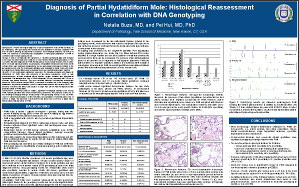Diagnosis of Partial Hydatidiform Mole: Histological Reassessment in Correlation with DNA Genotyping
Natalia Buza, MD, and Pei Hui, MD, PhD
Departments of Pathology, Yale School of Medicine, New Haven, CT, USA
ABSTRACT
Background:
Routine histological diagnosis of partial hydatidiform mole (PHM) continues to be challenging. DNA genotyping has recently become available to precisely separate PHM from its mimics, allowing an opportunity to reassess the histological criteria for the workup of PHM. We undertook a comprehensive reevaluation of histological parameters of PHM in correlation with DNA genotyping results.
Design:
A total of 143 early abortion specimens (<16 weeks gestational age) were included in the study. All cases have been subjected to short-tandem-repeat (STR) genotyping. Of the 143 cases, 60 were diagnosed as PHM, 52 had various chromosomal trisomies, and 31 cases were non-molar diploid gestations by genotyping. All available hematoxylin and eosin (H&E) stained slides were reviewed independently by two gynecologic pathologists blinded to the genotyping results, and the morphologic variables were evaluated in detail. Cases with major discrepancies in interpretation were re-reviewed by the two specialty pathologists together.
Results:
Of the morphologic parameters assessed, the following emerged with diagnostic significance for PHM: villus size, presence of two villous populations, round or oval pseudoinclusions, at least moderate villous hydrops, cistern formation and trophoblastic hyperplasia. The average villus size of PHMs measured 3.2 mm, compared with 2.2 mm in trisomies and diploid abortions. The most sensitive (although non-specific) morphologic feature for PHM is villous hydrops (86%), or presence of at least one of the following three parameters: two villous populations, round or oval pseudoinclusions and cisterns (84%). The presence of cisterns and villous size equal to or larger than 2.5 mm had the highest positive predictive value for PHM (90%).
Conclusions:
Confirming previous studies, significant histological overlaps exist among PHM, hydropic abortions and chromosomal trisomy syndromes. The presence of any one of the following histological findings should prompt DNA genotyping workup to rule out PHM: round or oval pseudoincludions, cistern formation, two populations of villi and villous size of 2.5 mm or larger. The presence of both cisterns and villous size of 2.5 mm or larger has a 90% positive predictive value for PHM.
©2012 Yale Department of Pathology. All rights reserved.
Any redistribution or reproduction of part or all of the contents in any form is prohibited. You may not, except with express written permission of the author or the Department of Pathology, distribute or commercially exploit the content, nor may you transmit it or store it in any other website or other form of electronic retrieval system, including use for educational purposes.
